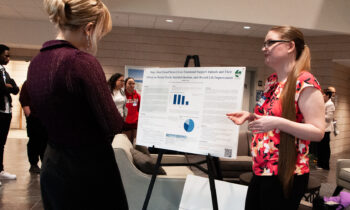First-in-the-nation Approach to Nurse Education and Staffing Changes How Nurses Are Trained By Modernizing the Traditional Clinical Education Model
Following a successful pilot of its innovative Academy of Clinical Essentials (ACE) initiative which puts a cohort of nursing students at the bedside under instruction of an experienced hospital-based nurse, the University of Maryland Medical System (UMMS) is preparing to welcome its first full class of nursing students as the initiative expands to more locations across Maryland. This academic-practice partnership model reimagines the preparation of student nurses and their transition to hospital practice and creates an integrated and innovative care delivery model.
“This is a significant opportunity for nursing students to get a realistic clinical experience, be immersed in clinical care for a full shift, and have accountability for patients from the beginning of their shift until handing off to the oncoming nurses at the end of their shift,” said Lisa Rowen, DNSc, RN, CENP, FAAN, Chief Nurse Executive for UMMS. “Caring for a patient for a full 12 hours allows nursing students to experience the continuum of care, engage with a patient’s family members and fully understand the patient care experience.”
ACE cohorts are assigned to hospital units for the duration of their clinical course, aligning with skills that nursing students are taught in their first or second year of nursing school. For one 12-hour shift per week, small cohorts of four nursing students each are paired with an UMMS-funded clinical nurse who serves as their instructor and who is experienced with the patient population of the specific unit, team members assigned there, policies, protocols, procedures and equipment.
“Historically, nurses received hands-on training under the guidance of an experienced hospital nurse, and the UMMS ACE teaching model returns the profession to its roots,” added Dr. Rowen. “Modern health care demands rigorous, in-class education for all nurses, and ACE blends the modern approach with real world experience that will result in graduates who are far more prepared to begin caring for patients, who may be the biggest beneficiaries of this approach that adds more hands and resources to hospital units.”
Students enrolled in Medical-Surgical Nursing for Associate Degree in Nursing, Bachelor of Science Nursing, and entry-to-practice Clinical Nurse Leader classes are eligible for the program. During their clinical rotation, the student nurses are embedded in the fabric of care delivery in their unit and are considered an integral part of the care team. Because students and instructors are immersed in specific units for long periods of time, one especially important aspect of the program is the inclusion of clinical instructors in staffing numbers at hospitals. Early pilots of the model have also shown that instructors benefit greatly from the UMMS ACE, which creates opportunities for experienced nurses who are passionate about teaching to have a diversified role and be more engaged at the hospital.
UMMS piloted ACE, believed to be the first such program in the country, in spring 2022, with seven cohorts of 28 second semester medical/surgical students. An additional 11 students in their first semester fundamental course joined the cohorts at mid-semester and were able to practice basic nursing skills. The cohorts were at the University of Maryland Medical Center (Downtown Campus), the System’s flagship academic medical center in downtown Baltimore, and the University of Maryland St. Joseph Medical Center.
Participants were all students at the University of Maryland School of Nursing (UMSON); the program is expanding for the fall 2022 semester to involve nursing students from all three campuses of the Community College of Baltimore County and Chesapeake College on the Eastern Shore. ACE is also being expanded to additional UMMS hospitals; the University of Maryland Medical Center (Midtown Campus), UM Baltimore Washington Medical Center in Glen Burnie, UM Upper Chesapeake Health’s two hospitals serving Harford County, UM Shore Regional Health facilities, and UM Rehabilitation and Orthopaedic Institute. More than 30 nursing cohorts with more than 120 nursing students are planned for the fall 2022 semester.
Rasheda Dukhin was an ACE initiative student in spring 2022, gaining clinical experience on UMMC’s Thoracic Intermediate Care Unit. “This was an amazing experience that made me feel ready to practice nursing upon graduation,” she said. “Many of the patients I cared for were high acuity; I got experience with all patient care, assisted physicians with medical procedures, administered medications, documented assessments, drafted reports and more,” said Dukhin, a resident of Rockville. “During the semester I was able to directly align lecture material to clinical practice, and it allowed me to better understand and absorb the material. The clinical instructors were a great part of my success because they challenged me, gave me autonomy and were patient and willing to teach me.”
“Nursing students participating in the ACE program will undoubtedly be better prepared for their nursing careers because this education offers them the reality of being a nurse in health care right now,” said Dr. Rowen. “Practicing skills in a simulation lab with mannequins is an important part of nursing education, and adding this immersive type of hands-on experience is invaluable. Nursing students will become more confident and proficient in clinical skills and in their professional relationships with multidisciplinary team members. The goal is for these students to require less orientation time on their unit when they are hired so they can practice independently sooner.”
Goals of ACE include improving the student nurses’ education experience with experiential learning by embedding them in hospital culture, bolstering the nursing workforce, recruiting students to join the UMMS workforce as new nurse graduates, decreasing orientation costs over time and providing opportunities to diversify the roles of UMMS nurses to ensure they stay more engaged within the organization and enable their professional advancement.
Robbie Francisco, BSN, RN, PCCN, a Senior Clinical Nurse I who has worked at UMMC for 15 years, was one of the instructors for the spring ACE pilot and said, “it was rewarding to see the students learn bedside skills and grow more confident each shift.” Francisco typically helps orient new nurses as a preceptor so is comfortable working with recent graduates, but this was her first time as an instructor. “The idea intimidated me in the beginning, but I thought of it as a new challenge and an amazing opportunity for me to grow as an educator as well as a bedside nurse, and I saw it as a venue to share my experiences and knowledge to help cultivate new generations of nurses.”
Another first-time instructor, Genevieve Vidal, BSN, RN, PCCN, who also holds the position of Senior Clinical Nurse I, said her goal was to teach students the realities of nursing at the bedside. “I was fortunate to have motivated students who were always helping each other and lifting each other up during challenging shifts,” Vidal said. Celebrating her 20th year as a UMMC nurse this year, Vidal encouraged the students to have initiative, challenged them to stretch beyond their comfort zones, focused on patient communication and bedside nursing skills, taught students how to draw blood and place IVs and “saw their confidence grow as they continued to master skills in their clinical training.”
Deborah Trautman, PhD, RN, FAAN, AACN President and Chief Executive Officer of AACN and a board member of UMMC, is a strong supporter of the ACE program. “In April 2021, the American Association of Colleges of Nursing released new guidelines for nursing education, urging schools of nursing to adopt a more experiential and competency-based framework for preparing professional nurses,” she said. “The UMMS ACE model illustrates how practice and academic leaders can work together to meet these new expectations, which will take the profession of nursing into the future.”
Maeve Howett, PhD, APRN, CPNP-PC, CNE, Professor and Associate Dean for Baccalaureate Education at UMSON, added, “The ACE program has provided excellent learning opportunities for our students in a time of critical need for additional nurse educators and sites. Our ongoing partnership with UMMS has successfully contributed to being able to increase enrollments to help meet the growing demand for nurses in Maryland. ACE has created an enthusiasm among experienced UMMS nurses to help teach and mentor the next generation of nurses. We are thrilled with the outcomes of the spring pilot and look forward to the expansion of ACE this fall term”.
Key nursing national stats: (per the United States Bureau of Labor Statistics)
- The average age of registered nurses (RNs) has increased to 52-years-old
- Nineteen percent of the RN workforce is 65 or older, up from less than 15% in 2017
- Greater than 20% of RNs report they plan to retire from nursing within the next five years
- Employment opportunities for RNs are expected to grow 9% between now and the year 2030, with about 194,500 openings projected annually
- By 2030, the United States could be short as many as 1.9 million nurses
“Staffing is a frequent challenge, and nurses are often being asked to take on more tasks than ever before,” said Dr. Rowen. “The UMMS ACE model can serve as a prototype for academic-practice partnerships to support the education of student nurses, hospital staffing and growth of the nursing workforce.”
Feedback from ACE student participants:
- “I loved being able to dive right in. While my peers were doing simulations on the computer or in the lab, I was getting first-hand experience.”
- “This experience should be for everyone! We are working as soon as we walk in the door, and we do everything.”
- “I feel more prepared for my nursing career.”
About the University of Maryland Medical System
The University of Maryland Medical System (UMMS) is an academic private health system, focused on delivering compassionate, high quality care and putting discovery and innovation into practice at the bedside. Partnering with the University of Maryland School of Medicine and University of Maryland, Baltimore who educate the state’s future health care professionals, UMMS is an integrated network of care, delivering 25 percent of all hospital care in urban, suburban and rural communities across the state of Maryland. UMMS puts academic medicine within reach through primary and specialty care delivered at 11 hospitals, including the flagship University of Maryland Medical Center, the System’s anchor institution in downtown Baltimore, as well as through a network of University of Maryland Urgent Care centers and more than 150 other locations in 13 counties. For more information, visit www.umms.org.




